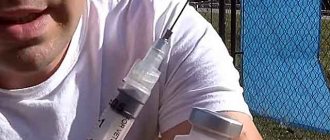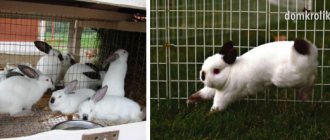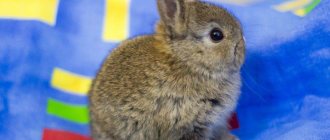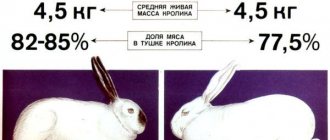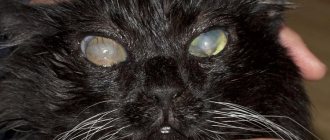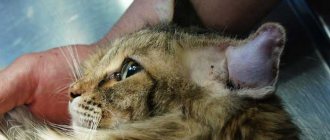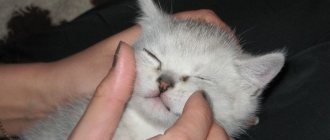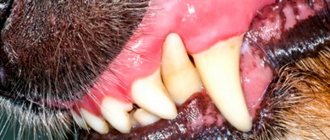How to distinguish healthy rabbits from sick ones
It is worth remembering that many rabbit diseases can initially be asymptomatic, which makes timely diagnosis difficult. However, constant monitoring will not hurt. It is recommended to regularly examine rabbits, observe their behavior, and at the slightest changes, take appropriate preventive measures to prevent the spread.
The main thing to remember is that most diseases in the initial stages are much easier to cure than in advanced conditions.
Signs of a healthy rabbit:
- The animal is active, with a good appetite.
- The coat is smooth, without bald spots, and shiny.
- No discharge from eyes or ears.
- Respiration rate – 60/min.
- Body temperature - 38.5C - 39.5C.
- Pulse - 120-160/min.
- There are no changes in stool (stool is dark brown or black, bean-shaped in shape; urine is dark).
Diseases of rabbits dangerous to humans
Diseases of rabbits that pose a danger to humans:
- Cysticercosis . Prevention - taking antihelminthic drugs.
- Fascioliasis . To prevent illness, thorough hand washing after contact with animals is necessary.
- Pasteurellosis . Regular disinfection of cells is a way to prevent infection.
- Listeriosis. Prevention – compliance with hygiene standards.
- Tularemia. Disinfection of hands and clothing is required.
Main signs of a sick rabbit
If, upon examination, the slightest change in behavior or appearance is detected in a rabbit, you must immediately call a veterinarian. Each individual disease has its own symptoms.
But there are a number of general signs that indicate that the rabbit is sick:
- Abnormal activity or, conversely, previously unusual passivity of the animal.
- Poor appetite or complete refusal to eat.
- Thirst.
- Frequent, uneven breathing.
- Hair loss.
- Discharge from the nose, eyes, genitals.
- Formation of tubercles, ulcers, and seals on the body.
- Convulsions, paralysis, trembling of limbs.
- Diarrhea or constipation.
- Ears droop (unless this is a characteristic feature of the breed).
After which meat is not suitable for food
In terms of its composition and benefits for humans, rabbit meat is ahead of many other types of meat . It contains a large number of useful elements and vitamins, and is also dietary and hypoallergenic. The meat of rabbits suffering from parasitic and infectious diseases (helminthiasis, fascioliasis, listeriosis, coccidiosis and others) should absolutely not be eaten. If the disease was caused by internal pathologies, injuries or a cold, then rabbit meat is completely safe.
Meat from rabbits that have suffered infectious diseases is not suitable for consumption.
Contrary to popular belief, rabbit meat that has recovered from myxomatosis can be eaten without harm to health. However, it is recommended to destroy a sick animal, since it poses a great danger to healthy individuals.
What types of diseases are there?
Diseases of rabbits can be non-contagious and contagious (they are quickly transmitted from animal to animal, sometimes to humans).
Non-contagious or non-infectious diseases do not threaten the life of the animal, but can cause some harm.
Infectious pathologies arise from viral or bacterial infection, spread with lightning speed and can destroy the entire rabbit population.
A separate group includes invasive diseases that occur when parasites enter the body of long-eared animals.
Every rabbit breeder needs to be able to recognize the symptoms of a particular pathological condition in order to be able to help the animals in time before the doctor arrives, to protect the herd from the spread of a particular infection, and to preserve the health of their pets in the future.
Non-communicable diseases
Non-contagious diseases in rabbits are mostly treatable. But the lack of timely diagnosis and treatment can lead to serious irreparable consequences. This group includes the following pathological conditions.
| Name | Cause | Symptoms | Treatment | Prevention |
| Diseases of the gastrointestinal tract | “Hair balls” in the stomach, unhealthy diet, ingestion of poor quality food. | Diarrhea or constipation, mucus or blood in the stool, the animal refuses to eat, bloating, lethargy, hypersalivation (a lot of saliva is produced). | On the first day, restriction in food, giving sorbents, drinking rice or oatmeal solution. For severe intoxication and prolonged constipation, use laxatives. | Monitoring the quality of products, adding probiotics to food to normalize the microflora of the stomach and intestines. |
| Frostbite | Extended exposure of animals to the cold. | Swelling and drooping ears, dermatitis, necrosis of part of the skin, as a complication, pneumonia can develop. | Disinfection of frostbitten areas of the skin with antiseptics, treatment with healing ointments based on dexpanthenol; for complications - antibiotic therapy. | Timely insulation of places of detention for the winter, replacement of metal floors with wood ones. |
| Heatstroke | Keeping animals in direct sunlight or in a stuffy, unventilated room. | The animal breathes frequently, apathy, impaired motor activity, and in severe cases, convulsions and even death of the animal. | Immediately move the rabbit into the shade, into fresh air, and cool it with cold lotions. | Controlling the temperature in the room where the animals are kept, placing cages in shaded areas. |
| Allergic reactions | Dampness in the cages, a lot of dirt and dust, lack of ventilation, not enough light. | Increased body temperature of the rabbit, change in color of mucous membranes, discharge from the eyes and nose, frequent sneezing, rapid breathing. | Immediately change the environment or place of residence of the animal, give antihistamines, sorbents. | Arrangement of comfortable conditions for raising eared animals. |
| Skin diseases Pododermatitis | Raising animals on slatted floors. | Baldness of the limbs, roughness, cracks and suppuration on the paws. | Treating the paw skin with antiseptics and antibiotic ointments. | Arrangement of bottoms in cages with zones without slats or complete abandonment of this type of bottoms (recommended for large purebred rabbits). |
| Mechanical injuries | Cramped cages, crowded animals, violation of mating rules. | Scratches, swelling, bruises, numerous hematomas on the body. | The bruised areas are cooled, the damaged skin is treated with antiseptics, and in case of suppuration, with antibacterial ointments. | Controlling the number of animals in the cage, monitoring eared animals during mating. |
| Avitaminosis | Lack of essential vitamins and microelements. | Rickets (in rabbits), hair loss, slow growth, lethargy, or vice versa - hyperactivity. If a rabbit's paws fail, this may indicate both a lack of calcium in the body and injuries to the limbs or spine. | Adding vitamin premixes and complex dietary supplements to food. | Control over nutrition and its diversity. |
Invasive (parasitic) diseases
Rabbits can get sick when they are infected with a variety of parasites. Such parasitic diseases are also called invasive. Parasites interfere with the normal functioning of rabbits and deplete fragile rabbit bodies.
The most common type is considered to be “helminthic infestation”. Only a specialist can find out which worms have settled in a rabbit based on the tests performed.
| Name | Cause | Symptoms | Treatment | Prevention |
| Cysticercosis | Dog parasites are cestodes. | Bubbles with parasites on the rabbit’s liver, in the meninges, in the chest and abdominal cavities (discovered at autopsy). | Difficult to treat. Benzimidazole-based drugs are used. | Restriction or exclusion of dogs from the territory of the rabbit farm. |
| Coccidiosis | Coccidia. | Symptoms resemble poisoning (diarrhea, lack of appetite, bloating). Upon opening, the intestinal walls are destroyed by single-celled parasites. | Coccidiostats, antibiotics, and probiotics are prescribed. | Give water with iodine, keep the rabbits' homes clean, and use food with the addition of coccidiostats. |
| Fascileosis | Swamp trematode mollusk. | Fever, swelling of the eyelids, jaundice, convulsions, severe shedding. | Carbon tetrachloride is used for deworming. | Disinfection, not allowing third parties and animals into the farm territory. |
| Pediculosis | Fleas, lice. | Scratching, baldness, thinness. | Treatment with special anti-pediculosis agents at home. | Constant inspection of the coat to identify parasites and their larvae, and carrying out preventive disinfestation. |
| Psoroptosis (ear scabies) | Scabies mites. | If animals become infected with psoroptosis, they develop ear sores. A sick rabbit shakes its head and combs its ears. Scales form on the surface of the ears. | Removing scales and crusts from the ears, and then treating the affected areas with acaricides and antiseptics. | Moving infected pets to quarantine until complete recovery. The cells are burned and treated with creolin. |
Infectious diseases
Infectious diseases are the most dangerous for rabbits. Some of them can cause mass mortality due to the rapid spread of the pathogen through contact or airborne droplets.
The most unprotected are considered to be baby rabbits after 1 month, weakened adult animals that have poor immunity. To prevent infection, it is recommended to give immunostimulants to rabbits.
| Name | Cause | Symptoms | Treatment | Prevention |
| Staphylococcosis | Staphylococcus | Purulent formations on the skin and mucous membranes, temperature rise up to 42C, in lactating rabbits - swollen nipples, pus in the milk. | There is no treatment; meat from sick animals is dangerous for human consumption. | Periodic inspection of animals, disinfection of premises. |
| Trichophytosis (ringworm) | Fungus | Round spots of different sizes appear on the skin, which are covered with scales and crusts. The animal is very itchy. | Treatment of affected areas with antifungal ointments and antiseptics. | Isolation, quarantine, disinfection, vaccination. |
| Spirochetosis (treponemosis, “rabbit syphilis”) | Bacteria | Swelling of the genital organs, mucus discharge, pus from them, ulcers, growths appear. Hair may fall out. | Antibacterial therapy. | Monitoring the health of animals that are subjected to mating. |
| Listeriosis | Pathogenic listeria (pregnant rabbits are more likely to get sick). | Paralysis of the hind legs, convulsions, enlarged liver and spleen. | There is no cure. | Animals are burned, the habitats of sick rabbits are thoroughly disinfected, burned, and periodically deratized. |
| Colibacillosis (colibacteriosis) | Escherichia coli | Animals move little, become apathetic, restless, lose their appetite, experience diarrhea (there is a lot of mucus and gas bubbles in the stool), pregnant females abort, coma and convulsions are possible. | The first day - a starvation diet, and then (until recovery) - only easily digestible food. Antibiotics and nitrofurans are also prescribed. | Isolation of sick individuals, disinfection of equipment and premises. |
| Myxomatosis | Virus | Conjunctivitis, reddened skin, swelling, nodules on the body, swelling and drooping ears, thinness, discharge (sometimes with pus) from the eyes, fever, nodules on the skin. | The acute form is incurable and ends in death. In the chronic (nodular) form, antibiotics are prescribed, and the eyes and nodules are washed with antiseptics. | Vaccination. |
| Pasteurellosis (hemorrhagic septicemia) | Virus | In acute cases, conjunctivitis, sneezing, rabbit fever, diarrhea, nasal discharge appear, and within a couple of days the rabbit dies. In the atypical form, ulcers appear. | Only the atypical (pustular) form of the disease can be treated. Antibiotics and sulfa drugs are prescribed. | Long-term quarantine for recovered long-eared animals, disinfection of cages and equipment, burning of dead animals, vaccination. |
| Infectious stomatitis ("weed") | Virus, injury, metabolic disorder. | Rabbits up to 3 months are susceptible. White coating on the tongue, the appearance of ulcers in the mouth and nose, redness of the lips and chin, exhaustion, and sometimes diarrhea. | Treatment of affected skin and mucous membranes with a solution of copper sulfate (2%), Lugol's solution, powders based on antibiotics and nystatin. | Disinfection, periodic inspection of animals. |
| Tularemia | Bacterium | Cough, difficulty breathing, and when pregnant, the rabbit is aborted. Sometimes paralysis of the animals is observed. Pustules appear throughout the body, and the lymph nodes become enlarged. | Antibiotics and sulfa drugs are prescribed. Unfortunately, the risk of death of diseased individuals is up to 90%, even with treatment. | Animals that have recovered from the disease develop lifelong immunity to the disease. For prevention, it is worth carrying out constant disinfection, disinfestation, and deratization. |
| Infectious rhinitis (“contagious runny nose”) | Different types of bacteria | The nose is itchy, there is constant discharge, frequent sneezing, dacryocystitis (inflammation of the lacrimal sac in the eye). | The temperature in the room should be adjusted and nutrition should be improved. It is recommended to give immunomodulatory drugs, and drip a 1% solution of furatsilin into the nose. If the course is complicated, use antibiotics. | Strengthening the immunity of animals, carrying out disinfection, selecting fortified food. |
| Dermatitis (dermatomycosis) | Different types of fungi | Itching, peeling skin, hair loss. | Antifungal ointments are applied to sore areas. | Keeping animals clean and disinfecting. |
| Rabbit viral hemorrhagic disease (RVHD) | Virus | Asymptomatic. Sometimes fever and lethargy are noted in animals; before death, nosebleeds occur; when dying, they can snort loudly. | There is no treatment. | Ill and surviving individuals become immune to the disease for life. Dead animals are burned, cages are disinfected, containers and manure from sick animals are buried to a depth of 3 m. The main prevention of diseases is vaccination of eared animals. |
Parasitic diseases
Some parasites live on the surface of the skin or in the epidermis of rodents. These are fleas, lice and ticks. Others are parasitic inside the body. These include helminths and protozoan microorganisms.
Coccidiosis
Eimeriosis of rabbits is an acute disease of young animals caused by single-celled parasites. Coccidia affect the intestines or liver, less often both organs. You can determine that a rabbit is sick by the following signs:
- lethargy;
- weight loss;
- diarrhea alternating with constipation;
- bloating;
- feces with bloody inclusions;
- with liver damage and disease in a rabbit, the mucous membranes acquire a jaundiced tint.
Treatment for coccidiosis is effective if started at an early stage. Veterinarians recommend drugs such as Norsulfazole, Baycox, Sulfadimethoxine, Stop-coccid.
Encephalozoonosis
The causative agent of the disease is the simplest single-celled microorganism Encephalitozoon Cuniculi. When it enters the body, it first multiplies in the intestines and then spreads through the bloodstream to the tissues of the kidneys, brain and other organs. As a result, granulomas, or nodules, form there.
If the rabbit's kidneys are damaged, their thirst increases and weight loss occurs. The greatest danger occurs when pathogens enter the brain. This is evidenced by the following symptoms:
- convulsions;
- curvature of the neck;
- weakness of the hind legs;
- lack of coordination;
- disorientation in space;
- urinary incontinence;
- coma.
To treat this disease, anthelmintic drugs based on fenbendazole, B vitamins, immunostimulants and anti-inflammatory drugs are used. If there are irreversible changes in the brain, therapy does not make sense.
Ectoparasitoses (ticks, fleas)
Rabbits are parasitized by scabies and fleas. The disease psoroptosis is caused by a mite that burrows into the ears of a rodent and begins to multiply there. The parasite bores passages in the skin and feeds on blood. The animal experiences severe itching and pain, so it shakes its head and scratches its ears. The disease is treated with acaricidal drops Bars, Frontline. The drug Ivermec also helps get rid of psoroptosis.
Fleas are often found in the fur of rabbits, and they are carriers of infectious diseases. Infection with parasites is indicated by the appearance of bald spots and scratches on the rodent's body. He constantly scratches himself in different places and becomes nervous. Fleas can be seen with the naked eye if you part the fur on their neck, belly or face. To combat such parasites, insecticidal acaricidal drops are used on the withers.
Helminthiasis
Rabbits can be parasitized by different types of helminths. Most often these are round or flatworms. Rodents become infected with worms when they eat grass and ingest soil particles. Parasite eggs enter the animal's stomach and intestines and can infect the liver, heart and other organs. Types of helminthiasis in rodents:
- Passalurosis of rabbits.
This disease is caused by nematodes. Symptoms are stunting, weight loss, diarrhea, pale mucous membranes, bloating.
- Cysticercosis.
The causative agents of the disease are cestodes, which attack the intestines and liver. Signs of infection are constipation, poorly formed feces with mucus, hair loss, prolonged shedding.
Fenbendazole and Febantel are used to treat helminthiasis. The meat of sick rabbits is prohibited from being sold or used for cooking.
Common diseases of rabbits
In the first 30 days after birth, rabbits have very high immunity and are not susceptible to infection. But the death of young animals in the first month still often happens. Among the reasons are:
- low temperature in the queen cell;
- lack of milk in the rabbit;
- unsanitary conditions in the place of detention.
Rabbits older than 1 month suffer from the same diseases as adults. But, unfortunately, young animals suffer from diseases more acutely, so mass deaths of young offspring often occur.
Video TOP 5 FATAL DISEASES OF RABBITS
Use of drugs to treat diseases
To treat ailments in rabbits, a variety of medications are used, the prescription of which is carried out by a professional veterinarian after an accurate diagnosis has been established.
"Solikoks" for rabbits
The drug "Solicox" is intended for the treatment of the contagious disease coccidiosis. It is characterized by a wide range of effects and allows you to destroy all types of coccidia parasitizing the body. The medicine combines well with other medications and does not cause poisoning even with repeated overdose. Before use, the powder is diluted with clean water according to the instructions, then fed to rabbits for at least 12 hours a day.
Find out how to give Solikox to rabbits.
Lactic acid
Lactic acid is considered a universal drug used in the treatment of animals.
It has an antiseptic, antifermentative, disinfectant effect and is indicated for:
- gastritis;
- bloating;
- flatulence and diarrhea.
For external use, lactic acid is used to disinfect wounds, for abscesses, fungal and inflammatory lesions of the skin. Contraindications to the use of the drug are kidney diseases and weeping ulcers.
Read more about how to use lactic acid for rabbits.
Iodine
Iodine has long been known as a drug that has an antiseptic effect. For rabbits, iodine solution is a real elixir. It is used in the treatment of acute symptoms of coccidiosis, as well as for the prevention of digestive tract diseases. A few drops of potassium iodide tincture are added to water to prevent infectious diseases. Iodine is used to lubricate wounds or ulcers on the skin.
"Bycox"
"Baycox" is the first aid for many diseases of rabbits. It has an anticoccidial effect and, due to the main component - toltrazuril, it can effectively combat coccidiosis. It does not cause side effects, is characterized by excellent tolerability, and can be used with other medications.
We recommend that you learn how to give Baycox to rabbits.
The uniqueness of the drug is that it allows you to cure the disease at various stages - both at the initial stage and in advanced stages. When used preventively, it makes it possible to develop special antibodies to destroy infections.
Vaccine "Rabbivac V"
There are a number of diseases in rabbits, in particular hemorrhagic disease and myxomatosis, which cannot be treated. They are asymptomatic and lead to instant death of animals. Vaccination, for which the drug "Rabbivac V" is used, helps prevent such a fatal outcome. The vaccine is developed on the basis of a processed strain of hemorrhagic virus and allows you to activate the development of immunity to a certain type of disease.
Before use, “Rabbivac” is diluted with water and administered subcutaneously or intramuscularly to the animal. It is recommended to vaccinate rabbits with a high risk of infection every six months.
Important! The vaccine is not a medicinal product and does not have a positive effect on already infected animals.
What diseases do decorative and dwarf rabbits suffer from?
Diseases of decorative rabbits are the same as those of their large relatives. They especially often suffer from skin diseases (when kept in mesh cages) and parasitic infections (when keeping dogs, cats or other pets in an apartment). In addition, there are several more pathological manifestations to which dwarf furry creatures are often exposed.
| Name | Cause | Symptoms | Treatment | Prevention |
| Malocclusions | Genetic predisposition. | Incorrect bite, overgrowth of incisors, abnormal growth of teeth, appearance of hooks on them. | Mechanical correction of teeth by a dentist. | Constant examination of your pet. |
| Cystitis (or cystitis in combination with urolithiasis) | Bacteria, salt deposits, kidney stones (common in neutered pets). | Frequent urination, fever, loss of appetite, red urine. | Diuretics, anti-inflammatory drugs, antibiotics (for severe disease). | It is recommended to adhere to a proper diet and use specific dietary foods. |
| Oncological diseases | Unknown. | Depending on the location of the tumor, the urine turns red (especially often with cancer in rabbits). | Surgical removal of a pathological neoplasm. | Proper diet, comfortable living conditions, walking pets. |
| Eye diseases: | ||||
| Exophthalmos | Inflammatory processes in teeth. | Protruding eyeballs. | There is no cure. Removing a tooth or eye can alleviate the disease. | Control of bite and tooth growth. |
| Mechanical eye damage | Overcrowding, cramped cages, fights between animals, dirt getting into the eyes. | Redness of the sclera, swelling of the eyelids, lacrimation, discharge of pus, acidification, uveitis (inflammation of the blood vessels of the eye). | An isotonic NaCl solution is instilled to rinse the eyeball, then antibacterial drops are dripped in a course. | Control of conditions of detention. |
| Cataract and Glaucoma | Unknown, but believed to be caused by diabetes mellitus, encephalitis, or as an age-related change. Glaucoma is formed due to increased eye pressure. | Cloudiness of the eyes, discharge from them, swelling of the eyelids, nodules on the cornea. Protrusion of the eyes. | Cataracts and glaucoma can only be treated in a hospital using surgical methods. | Constant monitoring by a veterinarian. |
| Epiphora | Blockage of the tear duct. | Profuse lacrimation. | Rinsing the eyes with isotonic solution and furatsilin, in case of suppuration - antibiotic drops. | Constant inspection. |
| Conjunctivitis | Lack of vitamin A, infection with viruses or bacteria, injuries, allergies. | Keratitis (inflammation of the cornea of the eye), swelling, lacrimation, redness, sometimes the eyes fester (with bacterial infection). | Eye rinsing with antiseptics, antibiotic drops. | Keeping animals clean and eating properly. |
| Chemical eye injuries | Getting white in the eyes or due to ammonia fumes from urine. | Swelling of the eyelids, redness. | The eyes are washed with saline and anti-inflammatory drops are instilled. | Maintaining cleanliness and hygiene. |
How to treat
Treatment of rabbits requires an individual approach depending on the type and degree of the disease. Diagnosis is carried out by a veterinarian.
If we are not talking about diseases with 100% mortality, you can cure rabbits at home. Prescribed medications:
- In case of coccidiosis, affected animals are given drugs containing sulfonamides, for example Norsulfazole, in their feed. The course of treatment is 5 days. The dosage is determined in accordance with the instructions.
- In case of myxomatosis, a sick pet is quarantined, using vaccinations for treatment. Healthy rabbits are transferred to another room, having previously disinfected the floor, cage walls, bowls and drinking bowls.
- Pasteurellosis is treated with antibiotic injections using Terramycin or Biomycin. Injections are given at intervals of 20 hours.
- For infectious stomatitis, the rabbit's mouth is treated with a solution of copper sulfate (2%) dissolved in water. Streptocide is also used by crushing ½ tablet and pouring it into the pet’s mouth.
- Rhinitis is treated with Furacilin solution 1%, instilling 8–10 drops into each nostril.
- For fascioliasis, anthelmintic drugs (Anvermin, Fascocide and others) will be required.
- Medicines against scabies are prescribed by a veterinarian depending on the type of mites. Scabs in the ears of rabbits are removed after softening them, and the cells are disinfected.
- In case of diarrhea, the rabbit is given an enema with castor oil or soapy water, and given a solution of Syntomycin (0.1 g) 1-2 times a day.
Disease prevention and vaccination
Any disease in rabbits is much easier to prevent than to treat. Among the preventive measures are the following:
- Correct conditions of detention.
- Only high-quality and fresh food.
- Daily cleaning of cages.
- Periodic disinfection of rabbit homes.
- Vaccination of furry animals according to the vaccination calendar.
- Quarantine on a farm when some rabbits are sick.
- Current disinfestation and deratization.
How to treat rabbits
Self-medication of rabbits is unacceptable. To make a clear diagnosis and select an appropriate treatment regimen for eared animals, it is necessary to consult a veterinarian.
Classification of diseases and their description
All rabbit diseases are divided into 3 types: non-contagious, infectious and invasive.
Non-communicable diseases include:
- bacterial paw infection (pododermatitis);
- mechanical injuries;
- heatstroke;
- frostbite;
- various allergic reactions;
- gastrointestinal problems.
The group of infectious diseases consists of:
- biting midge;
- staphylococcus;
- infectious rhinitis and some others.
Invasive diseases are:
- scabies;
- cysticercosis;
- myxomatosis;
- coccidiosis.
It should be noted that timely vaccination of the rabbit population allows one to avoid the emergence of many dangerous infectious diseases.
Diseases associated with damage or natural influences
In order to provide favorable conditions for raising rabbits, it is necessary:
- keep them clean;
- avoid drafts;
- protect from cold and summer heat.
If these rules are not followed, the following diseases may develop:
- Frostbite. If the cages are not insulated, frostbite of the ears may occur in frosty weather. The disease manifests itself as swelling and the appearance of blisters. If frostbite is minor, the animal should be moved to a warm room and given warm water to drink. The affected areas should be treated with any fat. In case of severe frostbite, it is necessary to treat with zinc or iodide ointment.
- Heatstroke or sunstroke. Occurs in hot weather, if the room has high humidity and is not ventilated. The rabbit constantly lies down, refuses food, breathes quickly, and the mucous membranes will be red. You need to move your pet to a well-ventilated area, cover its head with a damp cloth, and constantly cool it.
- Draft, dust, mold become causes of bronchitis, rhinitis, pneumonia. The disease manifests itself as hyperthermia, lethargy, rapid breathing, sneezing, and discharge from the nasal passages. Diseases are treated with furatsilin - they are dropped into the nose and solutions of antibacterial drugs are administered.
- Fractures, bruises. It is necessary to treat the damaged areas with iodine and apply a cold compress.
Eimeriosis
Eimeriosis, or coccidiosis, is a severe invasive disease of rabbits, causing great economic damage due to the lack of weight gain and mass mortality of animals. This is the most common pathology in rabbit breeding, affecting mainly young animals, but adults can also be affected.
The causative agent of the disease is coccidia oocysts (one of the stages of development of protozoa is the encapsulation of a fertilized egg). There are 9 types, of which one is localized in the liver or bile ducts, and all the rest are in the intestines: in the middle and lower part of the small intestine, the anterior part of the large intestine.
In the host's body, coccidia sporozoites, released from oocysts, invade the cells or submucosal layer of the intestinal wall or, having penetrated the vessels by hematogenous route, are carried into the liver, where they begin to divide, as a result of which first asexual cells are formed, and then sexual ones. The latter, after fertilization, form a zygote, which turns into an oocyst, or zygocyst. The oocyst is released into the external environment with animal feces, where sporozoites are formed in it.
The source of invasion is sick rabbits and coccid carriers. The route of infection is nutritional (with water and feed contaminated with oocysts). Factors of transmission of the pathogen can be contaminated bedding, tools, rodents, insects, birds, as well as caring personnel (if veterinary and sanitary rules for caring for animals are not followed).
We suggest you read: How to find out if a decorative rabbit is sick
The incubation period of the disease is 3-15 days. The course of the disease is acute (3–6 days) and subacute (2–3 weeks), but it can also be chronic with repeated infections, which often happens when rabbits are kept in dirty cages with solid floors.
At the beginning of the disease, the rabbits become lethargic, inactive, lose their appetite, but drink a lot. They develop diarrhea (liquid feces with mucus, foul-smelling, mixed with blood), as well as a runny nose and conjunctivitis. The abdomen becomes swollen, flabby and saggy, the hair becomes tousled and matte, the mucous membranes become jaundiced (in the liver form).
Convalescent and recovered rabbits become sources of coccidia within 1–4 weeks and are generally immune to re-infection with coccidia of only the same species.
The diagnosis is made on the basis of epizootological data (prevalence of the disease in the area, etc.), these symptoms of the disease, pathological and anatomical changes (the liver is enlarged and covered with yellowish nodules, the contents of the intestines are filled with curdled-bloody masses), as well as laboratory examination of feces.
Sick animals must be isolated and given a variety of coccidiostats. For treatment, phthalazole 100 mg (0.1 g) is used per 1 kg of live weight, norsulfazole in the form of a drink in a 0.5% solution, sulfapyridazine 100 mg in combination with 25 mg (25 thousand units) of monomycin, chemical coccide 30 mg each. All drugs are used in two 5-day courses. You can use trichopolum for 6 days at 20 mg/kg live weight per day with feed and salinomycin at 34 mg/kg live weight.
To reduce mortality from coccidiosis, you can give rabbits 0.1–0.2% iodine tincture in the morning instead of water. Lactating rabbits from the 10th to 25th day of lactation and young animals from 45-60 days of age (if they have not previously received iodine tincture) are given this drug in 200 and 100 ml doses, respectively. All other animals are given a 1% solution of iodine tincture: gestational rabbits - from the 25th day of gestation, 100 ml, lactating ones - until the 5th day of lactation, 100 ml, from the 30th to 40th day, 300 ml, for separated young animals - from 70-85 days of age, 100 ml.
The carcasses of rabbits forcedly slaughtered from coccidiosis are suitable for food, but without the liver and intestines, which are destroyed. Skins are used without restrictions.
Prevention of eimeriosis involves keeping young animals in isolation. Cages, premises, equipment are periodically cleaned and disinfected, and metal cages are burned with a blowtorch, treated with hot steam or water (80 °C) for 15–20 minutes. Manure is neutralized biothermally or in special installations.
Ectoparasites
This group includes all parasites that live on the external organs of rabbits. They can be temporary or permanent and are equipped with various organs that help them stay on the host’s body (hooks, claws, etc.). This group includes arachnoses (tick-borne infections) and entomoses, diseases associated with parasitism of insects.
Arachnoses: psoroptosis, notoedrosis
The most common infections in rabbits are sarcoptic mange and notoedrosis (pruritic scabies), which are caused by small skin mites. As well as psoroptosis and chorioptosis (ear scabies). The causative agent is the carpet beetle mite. The disease is accompanied by severe itching. The animal scratches the skin vigorously, a scab forms at the site of the wounds, and the hair falls out. With psoroptosis, the entire auricle can be clogged with scab, and torticollis develops. If there are a large number of parasites and no treatment, the rabbit may die.
Entomoses or diseases caused by lice, fleas, lice eaters
These pathologies are caused by temporary and permanent parasites. Temporary parasites include:
- fleas;
- fly larvae.
Lice eaters are considered permanent parasites of lagomorphs, like lice. Lice cause a disease called sufunculatosis. Common symptoms for all these ailments are severe itching, scratching on the pet’s body, anxiety, deterioration in the quality of fur, and its loss.
Fly larvae parasitize individuals kept outdoors, in wounds or on skin around the anus ulcerated as a result of diarrhea. This is extremely rare in decorative rabbits living in apartments.
Vaccination of rabbits
Two of the worst viral diseases in rabbits— myxomatosis and hemorrhagic disease —are spread by mosquitoes and can be carried on your clothing. These are very severe and transient diseases that can kill a decorative rabbit in a matter of hours. And therefore, preventive vaccination of rabbits against these and some other diseases is necessary.
The first vaccination can be given to a rabbit when it reaches 45 days of age. In this case, the baby rabbit must weigh at least 500 g. First, the rabbit is vaccinated against myxomatosis , and after about 10 days it is vaccinated against hemorrhagic disease. There are also associated vaccines that provide protection against both diseases at once.
Rabbits should be vaccinated regularly. After the first vaccination against myxomatosis and viral hemorrhagic disease, the next one is given at 4.5 months. The rabbit should then be brought to the veterinarian for vaccination every six months, unless the veterinarian recommends a different vaccination schedule for the rabbit. This will significantly reduce the risk of illness for your furry pet, and if the disease does overtake the baby, the rabbit will have every chance of a successful recovery, and the treatment of the rabbit will be more successful.
In order for rabbit vaccination to take place without complications, it is necessary to first carry out helminth prevention. The rabbit owner can do it himself using medications recommended by the veterinarian. Under no circumstances should you vaccinate a sick or weakened rabbit, or a pregnant or lactating rabbit.
Passalurosis
Passalurosis is an invasive disease of rabbits and hares caused by a nematode, characterized by a chronic course, severe itching in the anus and digestive upset. Found everywhere.
The causative agent is the passalurus nematode (rabbit pinworm) of a spindle-shaped form that ends in a styloid process (Fig. 25). In the external environment, eggs are found in feeders, water, on the walls of rabbitry cages, and litter, where nematode formation occurs within 1–2 days. The period of development of passalurus from the beginning of infection of a rabbit to sexual maturity in the large intestine is 18–26 days, their life expectancy ranges from 70 to 106 days.
Rice. 25. Pathogen of passalurosis:
1 – head end; 2 – caudal end of the male; 3 – caudal end of the female (according to Schultz)
Rabbits aged 3-7 months are susceptible to this disease. Passalurosis can occur throughout the year. The route of infection is alimentary - ingestion of mature pinworm eggs along with food or water. It is possible for animals to be independently re-infected: sick rabbits, experiencing itching in the anus, scratch it, lick it with their tongue, thereby becoming infected with mature helminth eggs. The spread of this disease is facilitated by poor living conditions for animals.
We invite you to familiarize yourself with Birds in winter - Vegetable garden, garden, balcony - MirTesen media platform
The severity of clinical signs of the disease depends on the degree of invasion. With severe infection, rabbits experience pallor of the mucous membranes, a slight increase in body temperature, exhaustion, diarrhea (liquid feces, mixed with mucus), itching in the anal area. The animals become restless, take a sitting position, and rub their anus against the floor and walls of the cage. The skin around the anus becomes dirty, the fur sticks together, swelling, scratching, and redness appear. Rabbits lag behind in growth and development.
The diagnosis is made on the basis of epizootological data, clinical signs and laboratory research methods (helminth-ovoscopy using certain methods, as well as detection of eggs in scrapings from the anal folds).
For deworming rabbits, piperazine salt (adipate, phosphate, sulfate) is used, which is given once at a dose of 1 g/kg of live weight to adults, and to young animals - for 2 days in a row at 0.75 g/kg of live weight. You can also give phenothiazine at 1.0–1.5 g/kg live weight for 2 days in a row. The use of Panacur, mebenvet granulate, and tetramizole is also recommended.
To prevent the development of passalurosis, animals are provided with complete feed, cages are cleaned of manure and its biothermal disinfection is carried out daily, cages, houses, nest boxes and equipment are disinfected with boiling water, steam, and fire. Feeders and drinking bowls are cleaned in a timely manner. Newly arriving rabbits are subjected to helminth-ovoscopic examination.
